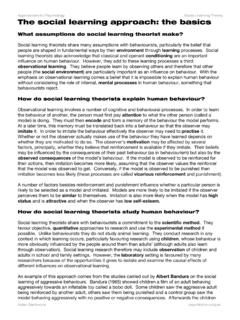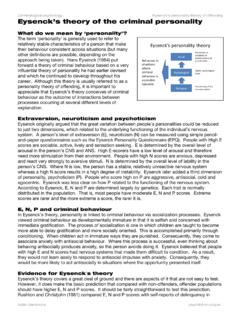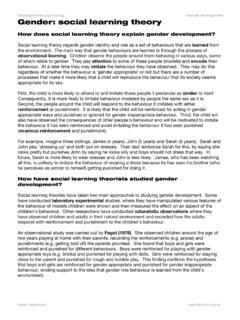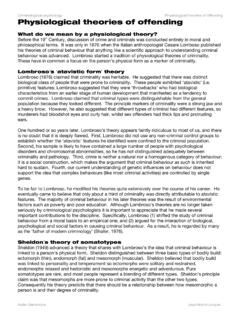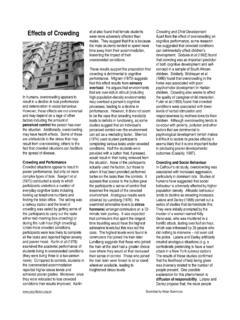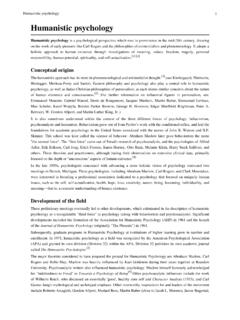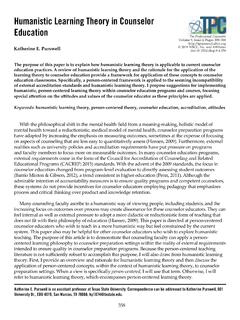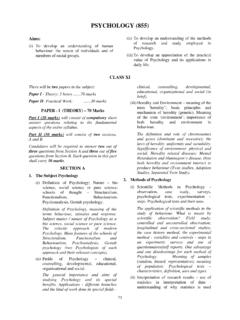Transcription of Humanistic psychology: Abraham Maslow - Psychlotron
1 Perspectives on psychology Humanistic Aidan Sammons Humanistic psychology : Abraham Maslow This activity will help you Understand the main ideas of Abraham Maslow Consider some of the strengths and weaknesses of the Humanistic approach What are our needs? Like Carl Rogers, Abraham Maslow believed that people were driven to fulfill their potential. His view was that we have certain needs that we need to fulfill. As we take care of one set of needs, a new set becomes salient. Much of Maslow s work was concerned with identifying the different types of needs that people have, and explaining why some people make more of their potential than others. Main Idea What s This? Hierarchy of needs Maslow thought that we are driven to satisfy our needs, but that some needs take precedence over others. For example, if you are hungry and thirsty you tend to take care of your thirst fist, because you can survive for weeks without food but only days without water.
2 Deficit needs Most of our needs are determined by deficits the lack of something. If we lack water we a driven to find it by thirst, if we lack food, we a driven to find some by hunger. Maslow also believed that we could be driven by a lack of safety, a lack of love and a lack of self-esteem. Growth needs The thing about deficit needs is that they go away once you have satisfied them. If you have eaten enough, you are no longer hungry. Growth needs are different. These are needs that continue to be felt and may even become stronger once you have engaged with them. These needs relate to really fulfilling our human potential. Self-actualisation Once a person had met all their deficit needs and engaged with their growth needs, Maslow believed that they might reach the stage of self-actualisation. Such people tend to be remarkable individuals such as Abraham Lincoln and Martin Luther King.
3 People who are self-actualisers are those who have made the most of their human potential. The Hierarchy of Needs As already mentioned, Maslow thought that some needs are more strongly felt and take precedence over others. For example, you might forget your hunger if you are thirsty enough, and your thirst becomes irrelevant if you can t breathe. By looking at how strongly different needs were felt, Maslow was able to arrange them into a hierarchy. In Maslow s hierarchy, the needs towards at the bottom are most important, and must be satisfied first. The needs are (in order of priority): Physiological needs food, water, oxygen etc. Safety needs freedom from threat and danger Belonging needs love, friendship and a sense of community Esteem being respected by others, having status and recognition Self actualisation fulfilling your human potential Perspectives on psychology Humanistic Aidan Sammons ridge.
4 Like Being In our development, we move through the levels of the hierarchy a bit like stages. An infant is concerned only with its immediate physiological needs. After a while it becomes aware of its needs for safety, and shortly afterwards starts feeling the need to love and be loved. Once these needs are satisfied, it begins to feel the need for self esteem and so on. Depending on how our lives turn out, we generally reach a level where our most important needs are satisfied most of the time. Our activities become habitually directed towards meeting the next set of needs that we have yet to satisfy. These then become our salient needs. However, at times when we are stressed or under threat then we may regress towards prioritising more basic set of needs. So a person might generally have esteem needs as their most salient, but if they suddenly lose their job or their partner it will become more of a priority to ensure that they are either provided for or loved, and esteem needs will take a back seat until this is done.
5 Problems or difficult circumstances at one point in a person s life can cause them to fixate on a particular set of needs, and this can affect their future happiness. For example, a person who lived through a period of extreme deprivation and lack of security in early childhood may fixate on physiological and safety needs. These remain salient even if they are satisfied. So even if this person later has everything they need they may nonetheless obsess over money or keeping enough food in the fThis, for Maslow , was the root cause ofmany neurotic mental health problems,anxiety or depression. Self Actualisation So, according to Maslow , a few people make it all the way to the top of the hierarchy of needs. Clearly, this means that all of their other needs are met most of the time so it should not be surprising that such people a rather rare.
6 Maslow reckoned that only one person in fifty actually made it to self-actualisation. What are the characteristics of such people? Self-actualisation Esteem needsBelonging Safety needs Physiological needs needsDeficit needs Needs have been met no longer salient Needs not yet salient Salient needs Primary range of salient needs Needs from the past still salient Perspectives on psychology Humanistic Aidan Sammons Self actualisers are: Reality centred they can tell the genuine from the fake in people Problem centred they view life s difficulties as problems to be solved Autonomous they are relatively independent Non-conformist the do not respond to social pressure to fit in They also tend to prefer solitude, and have a few really important personal relationships rather than I wide circle of shallower ones.
7 They also have a non-hostile sense of humour and are very accepting of themselves and others. Self actualisers typically have a strong sense of morality and ethics, but these are rarely associated with conventional religious beliefs. However, they are not necessarily perfect individuals and may have certain flaws or problems. For example, they may suffer from considerable anxiety and guilt, be absent minded and overly kind and occasionally have unexpected moments of ruthlessness, coldness and loss of humour. Some Questions to Think About Carl Rogers thought that everyone had the possibility of fulfilling their human potential, whereas Abraham Maslow had a very restricted idea of who could be a self actualiser. Which view do you prefer and why? Some of our greatest artists, writers, philosophers and scientists, far from being contented individuals, were bordering on the psychotic.
8 Does this fit with Maslow s notion that people can only become great if their deficit needs are met? Maslow s views on people s needs tie in very closely with the European and American ideal. But what of other cultures? Do Maslow s ideas necessarily apply to a Kalahari Bushman? Suggested Further Reading Gross, (1996): psychology : The Science of Mind and Behaviour. Diagrams based on s psychology Pages ~ )



